
By James Zug
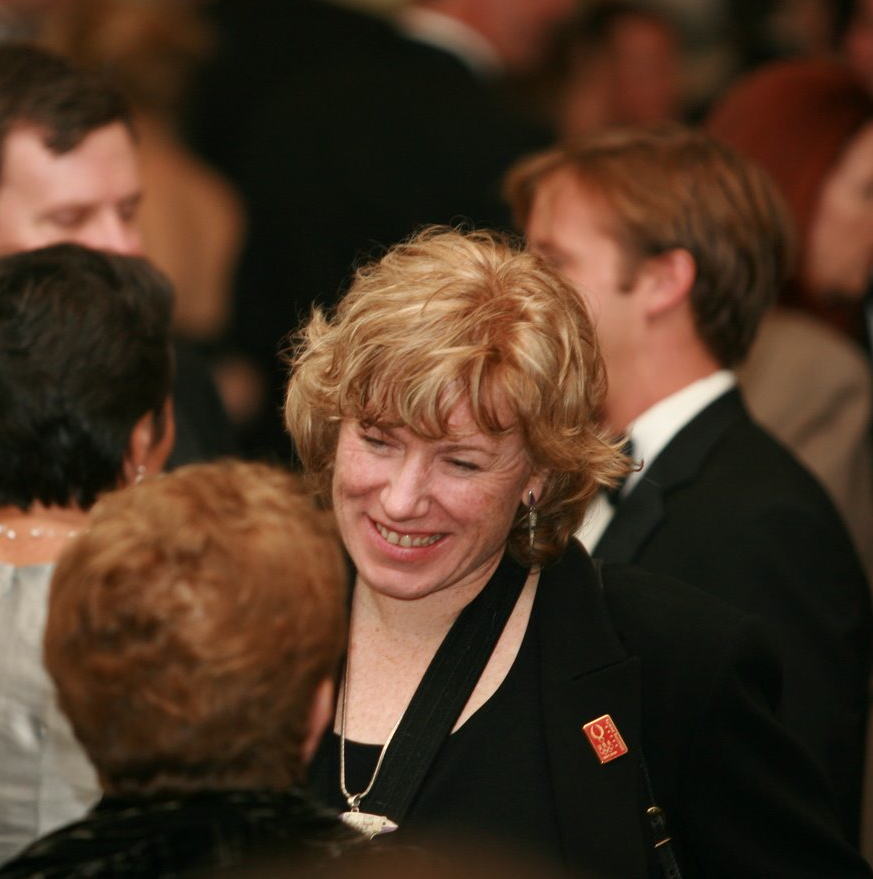
It was about storytelling.
Beneath the carapace of elegance and the thick scrim of black-tie and evening gowns and silver scoops of potato leek gratin and tangerine segment and cabernet reduction, it was just a brace of old and new friends gathered together and telling stories.
We heard about a broken arm while skating on a neighbor’s pond and summers at Buck Hill Falls and golfing in Singapore. We got jokes and poignant remembrances and a wonderful assortment of nibbly advice. Long-missed legends of the game, like Ed Faulkner and Richie Ashburn and Red Hoehn, were recalled. Like most times friends reunion, no one wanted to stop talking and end the evening. It was not until a quarter to midnight, well more than five hours after we arrived, that the lights came on and the video screen darkened and we slowly started to filter away onto Fifth Avenue.
It was officially titled the U.S. Squash Hall of Fame Gala 2008 but in reality, as the master of ceremonies Peter Briggs eloquently termed it, the Hall of Fame is really a Hall of Stories. “We are gathered to be sentinels to the stories of our past,” Briggs said.
Four years ago we gathered in midtown Manhattan to celebrate the centennial of U.S. Squash. The 2008 Gala, aimed to be an annual rather than once-a-century event, matched up to that historic evening when the current economic meltdown was considered: 319 people came this year and the Gala raised more than $100,000.
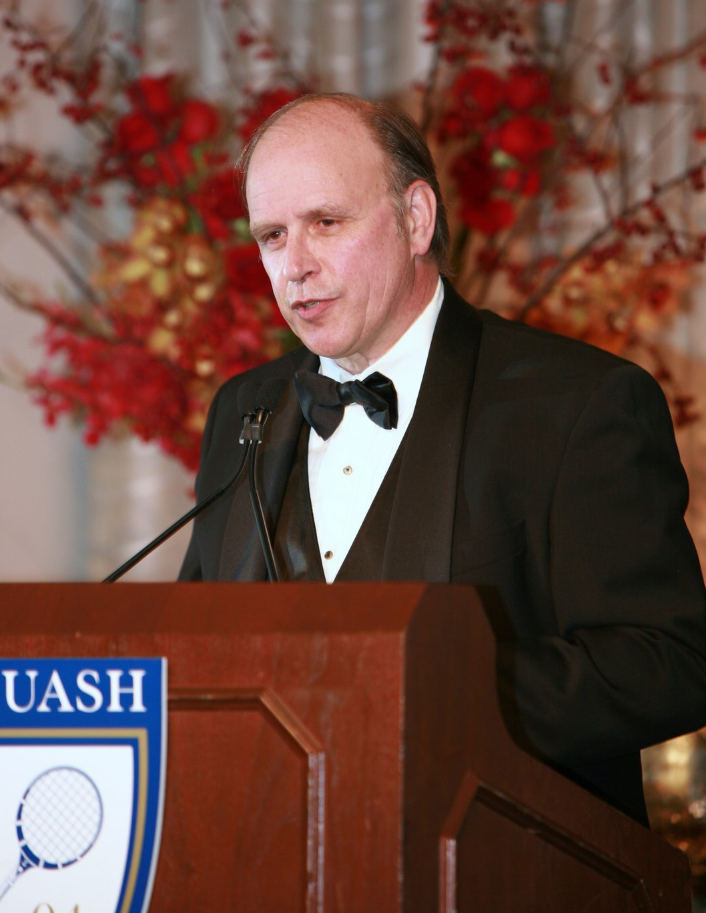
The Pierre provided a gorgeous atmosphere. As possibly the premier hotel in the city, it glowed so brightly that we almost felt it was 1950 again and Elizabeth Taylor, a former resident of the Pierre, might sashay into the ballroom. Beautiful flower arrangements, the Pierre’s signature desert compotier—we felt pampered.
That did not last too long, as Briggs managed to skewer everyone’s ego in style (how many of us can pronounce “perspicacity” and use it in a sentence?). The giant video screen at the front pumped out music and images at a furious rate—a spectacular touch was the montage of historical photographs that accompanied each awardee’s trip to the podium.
“You Make A Grown Man Cry,” by the Rolling Stones played while Jahangir Khan came up to accept the W. Stewart Brauns Award (given for substantial leadership and administrative contributions to the game). The song seemed appropriate. Briggs mentioned how Khan had won 555 consecutive matches in the 1980s. “I see neither you nor I have missed too many dinners recently,” Briggs kidded his fellow now slightly-rotund friend. Khan, who had flown in from Pakistan for the weekend, spoke about the Olympic dream for 2016.
A delicious dinner then came, though people hopped up and down, visiting other tables whenever there was no food on their own plate—pockets of hugging and laughing congregated at each table, Briggs kept the evening moving with his witty and wincingly appropriate jokes. We saw a short clip of Josh Easdon’s brilliant new film about Hashim Khan (it is premiering in January at the Tournament of Champions). Briggs then tossed in an addendum about Hashim. When he asked him one day about how he decided when to hit drop shots, what the tactics were, Hashim replied in his famously, boiled-down-to-the-basics way: “I see someone in front of me, I go deep; I see no one in front of me, I go short.”
The highlight of the evening was the induction of four people into the U.S. Squash Hall of Fame. Alicia McConnell, a Hall of Famer and former protégé of Carol Weymuller, said Carol, not John McCain, was the original maverick for her visionary ideas in the 1970s and 80s. So enthused was the crowd about welcoming Carol into the Hall, that one Heights Casino member, John Osnato, spontaneously jumped up to second McConnell’s remarks and talk about Carol’s reforming and transforming work.

Carol told about how a broken arm in childhood led to her father giving her tennis lessons to build back her strength which led to her playing No. 2 on her college’s men’s varsity tennis team (yes, men’s—Carol, as the accompanying inscriptions note, was good enough to play in the tennis U.S. Open) which led to her coming to the Heights Casino. Serendipidity.

Will Carlin, a former national softball champion and this magazine’s back-page columnist, passionately introduced Carol’s husband Fred. Carlin spoke about that late 1970s moment when the Guinness Book of World Records acknowledged that one street in Brooklyn Heights had the most nationally-ranked athletes in the world—and they were all junior squash players. Fred spoke about living at the Heights Casino as a bachelor and coming up with the revolutionary idea of teaching a group of players on one court.
Bill Doyle, former Harvard coach, discussed another magic moment in grassroots squash, when he described how a group of kids picked up the game at the Newport Squash Club. Kenton Jernigan was the best player amongst a large coterie of greats there. Jernigan, in accepting his induction, mentioned how he—living now in London—found it refreshing to walk into a room and see so many people he knew, how the American squash community was so warm and embracing, how much, he now realized, he missed it.
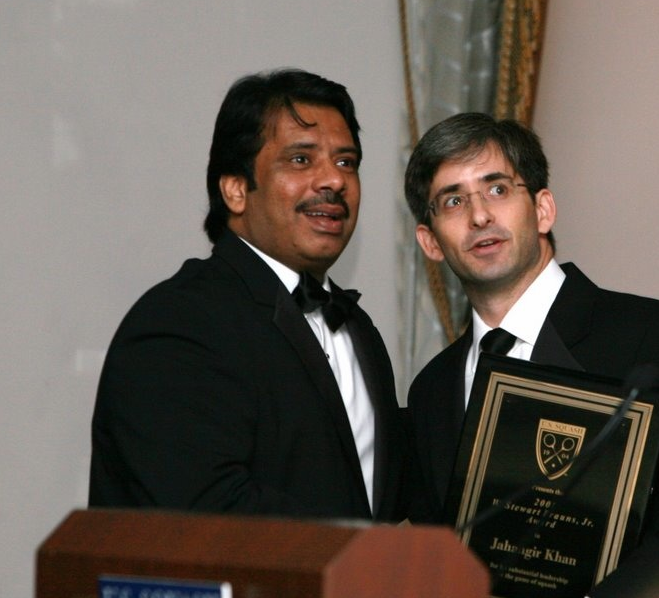
The three former men’s national intercollegiate champions from Penn—Palmer Page, Ned Edwards and Howard Coonley—then inducted their former coach Al Molloy. Edwards in particular spoke movingly about the Penn legend and mentioned a number of Molloy’s maxims: “Try easier” “quiet intensity” “try 90% not 100%” (to a hyped-up, nervous player) “If you want an easy match, schedule it with your grandmother” and “You want the ball to come back.”
The evening concluded with the surprise announcement of the winner of U.S. Squash’s most prestigious annual award, the President’s Cup. It went to Morris Clothier, the ten-time national doubles winner and a dynamic force behind the twenty-first century growth of hardball doubles. Clothier said afterwards that he knew something was in the offing when he walked into the ballroom and saw a group of his Franklin & Marshall fraternity brothers filling a table and looking sheepish.
It was that kind of night. The gift bags—handsome new Dunlop squash bags— were stuffed with more evidence of how great the U.S. squash community is. There were Harrow gift certificates and Dunlop squash balls (the white portable court kind—always shoot high, I guess) and posters of current national champions Julian Illingworth and Natalie Grainger, but the most intriguing item was a jar of Ming Tsai tea rub spice.
There has got to be a story there.
Class of 2008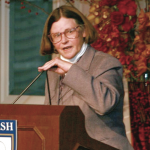 Carol Hunter Weymuller (1949— )
Carol Hunter Weymuller (1949— )
An unassuming and graceful squash revolutionary, Carol Weymuller pried open the door for women in the country’s largest squash city and coached two generations of champions. A top tennis player who won three Orange Bowl junior titles and played in the 1968 U.S. Open at Forest Hills, Weymuller joined her soon-to-be husband Fred at Brooklyn’s Heights Casino in 1970, where she helped run their vaunted junior program. Her most lasting legacy, however, is her leadership in the advancement of women’s squash. Weymuller started New York City’s women’s league and hosted the first women’s professional tournament in U.S. history with the 1977 Bancroft Open, as well as a women’s pro tournament at the Heights Casino which is now named in her honor. She coached the U.S. Junior Girls’ team at the 1980, 1981 and 1985 World Championships and after 1980 coached at a number of clubs in Rochester before assuming her present position as men’s squash and tennis coach at Hobart College in 1995. She served as U.S. SQUASH’s Women’s Division president from 1981 to 1983 and on at least one U.S. SQUASH standing committee from 1975 to 2007. As a player she was nationally ranked in the top ten a dozen times, won the Rochester city title eleven straight years, and played on the U.S. National team at the 1979, 1981 and 1983 World Championships. The only winner of the Achievement Bowl (1980), the Sportsmanship Trophy (1984) and the President’s Cup (1994), Carol Weymuller has played an essential role in developing junior, collegiate and women’s squash.
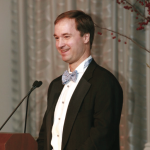 Kenton Jernigan (1964— )
Kenton Jernigan (1964— )
National Singles Champion 1983, 1984, 1985
North American Open Doubles Champion 1993
A precocious player who had a penchant for late-match heroics, Kenton Jernigan was, along with Mark Talbott, Ned Edwards and John Nimick, a member of the quartet of Americans who dominated U.S. squash in the 1980s. A Newport, Rhode Island native, he reached the finals of the Nationals in 1982 while a senior in high school; he won the National Juniors that same winter. In an unprecedented feat of dexterity, Kenton took both the National Hardball Singles titles and the brand-new National Softball titles in 1983, 1984 and 1985; he also won the National Softball Singles, the S.L. Green, in 1992. One of the most dominant intercollegiate players in history, Kenton lost just a single college match in his four years at Harvard, winning the National Intercollegiates in 1983, 1984 and 1986 and leading Harvard to four straight National team titles. Kenton played on the U.S. National Team at the 1983, 1987, 1989 and 1991 World Championships and also spent summers on the international softball tour, earning a world ranking of 65. As a hardball pro, he won the Tournament of Champions in 1991 and was ranked No. 2 on the hardball tour in 1989. On the left wall in doubles, Kenton teamed with Jamie Bentley to be the dominant tandem of the early 1990s, winning five Johnsons, one North American Open, two Cambridge Clubs and three Elites (the last in 1995 with Jeremy Fraiberg).
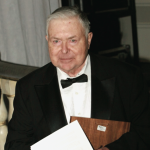 Charles Frederick Weymuller(1928— )
Charles Frederick Weymuller(1928— )
The innovative founder of the modern junior squash scene, Fred Weymuller changed the way many players first learned the game. In the late 1960s he developed a junior squash program at the Heights Casino in Brooklyn, where along with his wife Carol Weymuller, made it the model of all future club programs: the Weymullers were the first to take juniors to the Nationals (in 1982 all four girls’ division winners were protégés), the first to start a summer squash camp, the first to lead international summer squash tours, and at a time when most juniors were not allowed to play in private clubs, made the Heights Casino a hotbed of junior squash by inventing the method of group teaching. Among the dozens of champions to come out of their program was fellow Hall of Famer Alicia McConnell. Fred served on the first U.S. SQUASH Junior Committee and coached the U.S. Junior Boys team at the 1984 and 1986 World championships. Anticipating the change to softball, he was one of the earliest advocates for the game, starting softball leagues in New York and encouraging off-season play. He was also the first to suggest the idea of Bronze and Silver tournaments for less experienced juniors. As president of the North American hardball pro tour, he helped develop a certification process for teaching pros. From 1980 to 2000 he taught squash and tennis at the Genesee Valley Club, the University Club of Rochester and the Rochester Squash & Fitness Club. Awarded the President’s Cup in 1994, Fred Weymuller quietly and creatively led the late twentieth-century expansion of U.S. squash.
Albert G. Molloy, Jr. (1928—2000)
The beloved coach at the University of Pennsylvania, Al Molloy was the amiable but tough mentor who made the Ringe Courts at Penn one of the meccas of American squash. The son of a longtime teaching pro, Al was born in Brooklyn, raised in Westchester and studied at Virginia Military Institute before joining the Marines. He went on to work in Montreal and then the Tennis & Squash Club in Buffalo and was good enough to twice reach the finals of the Tournament of Champions. In 1959 he came to Penn to coach the men’s squash and tennis teams. Upon retiring in 1990, he had garnered a 215-101 record, with his team winning three Ivy League titles. He coached three national intercollegiate champions (Howard Coonley, 1966; Palmer Page, 1971; and Ned Edwards, 1979) and dozens of future squash stars and leaders. For fifteen years, he directed the Hunter Lott, making the tournament the most prestigious on the junior circuit. Ahead of his time, Al was the first college coach to embrace weight training, to make an instructional film and to actively recruit overseas players. He was also a proponent of softball, using the ball for off-season training, and often took his teams to England for holiday tours. Al authored two seminal books on squash and never failed to be an advocate for the youth and the inexperienced in the squash world.


